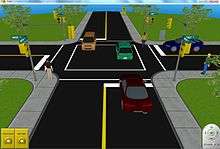PLCLogix
| Developer(s) | Logic Design Inc. |
|---|---|
| Stable release | V3.0 / Sept. 2015 |
| Operating system | Windows (XP, Vista, Windows 7, Windows 8, Windows 10) |
| Type | PLC circuit simulation |
| License | Proprietary |
| Website |
www |
PLCLogix is a Programmable Logic Controller (PLC) simulator that emulates the operation of the Logix 5000 PLC by Rockwell Automation. It provides users with the ability to write, edit and debug programs written using a tag-based format. Many of the most popular PLCs use tags, which are a powerful method of programming PLCs but also more complex. PLCLogix integrates tag-based ladder logic programs with 3D interactive animations to enhance the user’s learning experience.[1]
Overview
In order to properly understand the operation of a PLC, it is necessary to spend considerable time programming, testing, and debugging PLC programs. PLC systems are inherently expensive, and down-time is often very costly. In addition, if a PLC is programmed incorrectly it can result in lost productivity and dangerous conditions. PLC simulation software such as PLCLogix is a valuable tool in the understanding and learning of PLCs and to keep this knowledge refreshed and up to date.[2]
The operation of PLCLogix includes a graphical controller organizer and a point-and-click method of configuring various I/O. The application organization is based on using tasks, programs, and routine structures. In addition, it includes 64-bit data handling and incorporates both arrays and user-defined structures to provide emulation of real world industrial control systems. The Input/Output (IO) simulation provided by PLCLogix includes discreet, analog, and BCD IO modules. This IO chassis allows for the replication of a wide range of control applications including electronic speed control, A to D conversion, and high speed counting.[3]
Functionality
PLCLogix uses virtual models which consist of two layers: a graphic model layer and a mathematical model layer. The graphic model layer shows the corresponding ladder logic reflecting the various states of operation during program execution. The mathematical model layer is the core of PLC simulation and uses mathematical logic to create a ladder logic program. These mathematical models have input and output variables and define the mathematical relationship between input and output tags. PLCLogix has a graphical controller organizer and a point-and-click method of configuring various I/O. The application organization is based on using tasks, programs, and routine structures.[4]

PLCLogix was developed by Colin Simpson and John (Bud) Skinner.[5] It is primarily intended as an educational resource, and is used by high schools, colleges, and universities to provide laboratory simulation of industrial control applications.

Interactive Animations
One of the main features of PLCLogix is its ability to simulate real world manufacturing environments using interactive 3D animations. These interactive animations include bipeds and other avatars that operate in the various worlds. The integration of ladder programs with these 3D worlds provides a unique opportunity for programming in real-time and observing the operation of complex control devices and systems. Each of the 10 worlds in PLCLogix have interactive control panels which contain switches, pushbuttons, dials, levers, data input, thumbwheels, etc. The configuration of these control panels varies based on the operating requirements of the application. PLCLogix also includes a camera keypad with five camera views as well as a zoom function for all views. This allows the user to “move” around in the environment in order to gain a better understanding of the PLCs operation in its virtual 3D environment.[6]

The 3D interactive animations in PLCLogix allow programmers, electricians, engineering technicians, and engineers to test and troubleshoot ladder logic programs in a realistic simulated 3D environment, without worrying about incorrect I/O connections and programming errors that could result in damage to the equipment. Using simulation tools like PLCLogix, PLC programmers have the freedom to try all the "what-if" scenarios changing ladder logic instructions and programs, then re-running the simulation to see how changes affect the PLC's operation and performance. This type of testing is often not feasible using hardwired operating PLCs that control processes often worth hundreds of thousands – or millions of dollars.[7]
See also
- Automation
- Industrial Control System
- Programmable Logic Controller
- Simulation software
- PLC Technician
References
- ↑ Article about PLCLogix
- ↑ PLC simulation applications
- ↑ PLCLogix Article
- ↑ PLC simulation reference
- ↑ Programmable Logic Controllers, Pearson Education, 2012, ISBN 0-13-735861-X
- ↑ Article referencing 3DWorlds
- ↑ Advantages of PLC simulation
External links
| Wikimedia Commons has media related to PLCLogix. |